The death of the "eagle". The last victims of the Battle of the Atlantic demand justice
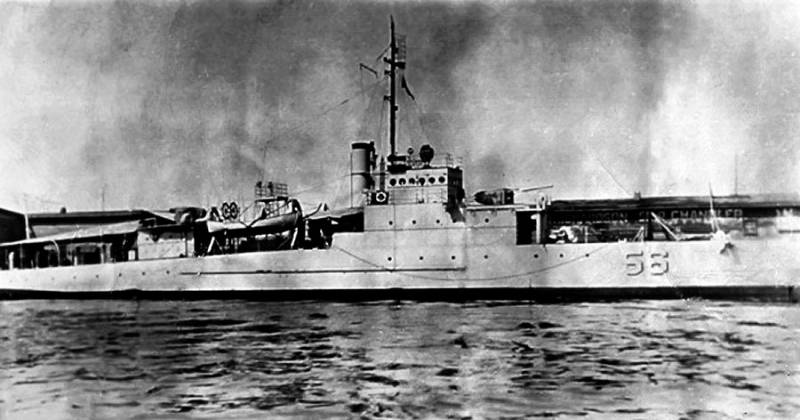
Ship
In June 1917, US President Woodrow Wilson invited tycoon Henry Ford to attend a meeting of the United States Shipping Board (USSB). This was a federal agency created in September 1916 to develop measures to increase the number of ships of the Navy and trading fleet, involved in the war with Germany and Austria-Hungary. This concerned, first of all, measures to build new ships. And so Ford, with his enormous experience in mass production, was proposed to be involved in the construction of ships. Naturally, no one expected battleships from him, but the war revealed the need for new types of ships, small ones, of which a lot was also required.
Ford was asked to build patrol vessels, which were primarily supposed to hunt for submarines. The vessel was to be all-metal, two hundred feet (60 meters) long, and superior in all respects to the 1917-foot-long wooden-hulled submarine hunters developed in 110. In fact, the ship became an intermediate link between destroyers and small hunters. Ford agreed to build such ships and took on the project with his usual enthusiasm. True, he was practically not involved in the development of the vessel itself, being more involved in developing the design of the plant and methods for producing ships. The plant was built in the suburbs of Detroit, on the Rouge River, from where ships on rivers and lakes could enter the Atlantic Ocean.
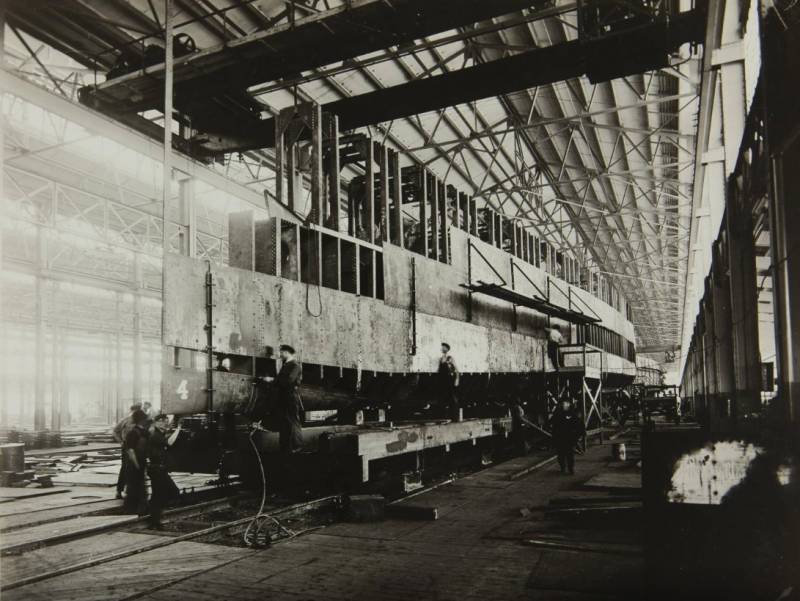
Assembly of the first ship of the series at the Ford plant, June 1918
The plant was built in 5 months, the first ship was laid down in May 1918, and the first finished hull was launched in July. True, problems began to emerge one after another immediately after the start of production. It turned out that the conveyor so beloved by Ford was not applicable for ships with a hull length of 60 meters. The workers at the Detroit plant who were brought in to build the ships had no experience welding large parts (Ford cars simply didn’t have that), so the US Navy officers who received them repeatedly pointed out to Ford the quality of the welds. At the factory, to speed up production, many workers worked on ladders and with hand tools, which led to the fact that they were simply unable to tighten the bolts with sufficient force. And then the war ended...
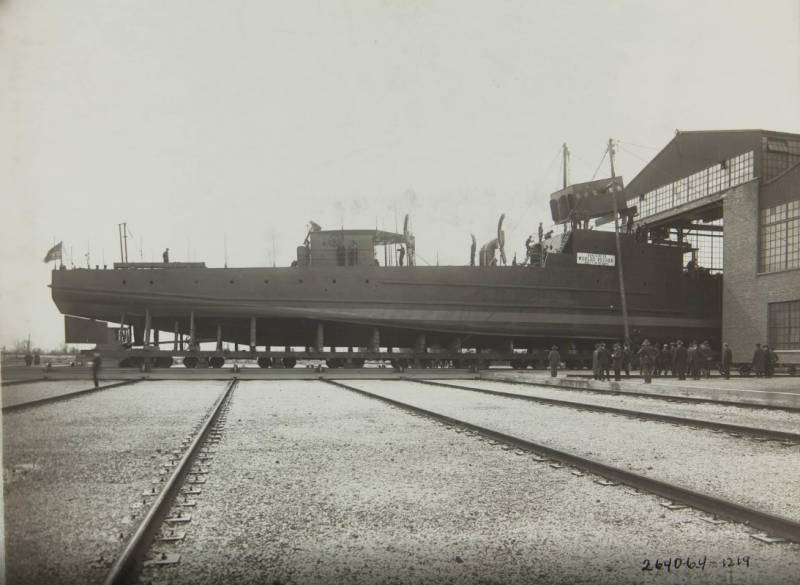
The future PE-59, partially deflated from the factory building, April 1919. This eagle body set a record; it was assembled in just 10 days. The ship itself was decommissioned and sold for scrap in 1938
The initial order provided for the construction of 100 ships, almost immediately it was expanded to 112, but already in 1918 it was cut down to 60. In 1918, 7 ships were delivered, the remaining 53 already in 1919. The ships received the name “Eagle” (Eagle-class patrol craft) , they didn’t make it in time for the First World War, and the need to build them later became the subject of discussion in the US Congress.
The military, naturally, did their best to prove the correctness of their decision, that the ships were needed at the moment, and the very idea of building such ships by an automaker was a unique experience. True, the operation of the ships showed that the performance characteristics themselves included in the project were too modest even for such tasks and that period; the ships have mediocre seaworthiness, and the quality of their manufacture often leaves much to be desired. This determined the future fate of the ships. Already in 1919, 5 of them were transferred to the US Coast Guard, where they received unflattering reviews and were not used for long.
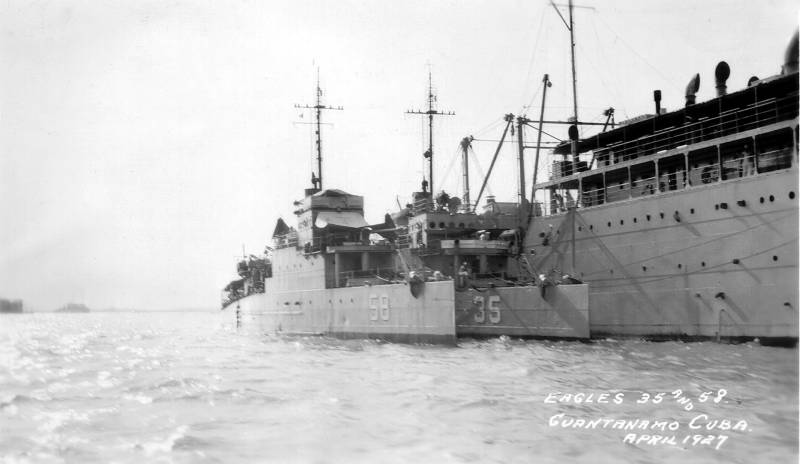
Two Eagle-class patrol vessels PE-35 and PE-58 in Cuba, Guantanamo, April 1927. There are 3 years left before the mass decommissioning of these ships
In 1930, the fleet immediately decommissioned 19 Orel class patrol vessels. Write-offs continued throughout the 1930s. The remaining ships were saved from being sold for metal by the US entry into World War II. In December 1941, there were 8 “eagles” in service. One ship was used as a training ship. Seven vessels were first used for their intended purpose, for anti-submarine patrol of the Atlantic coast of the United States. But quite quickly, more modern ships entered service or were received from the allies, and other occupations were found for the old men.
Tragedy of PE-56

A group of PE-56 sailors next to the ship’s wheelhouse, 1944-1945, photo from the personal archive of the family of one of the surviving sailors
It was April 1945. The Battle of the Atlantic had already been won, and the war in Europe was clearly coming to an end. On April 23, 1945, the Oryol class patrol ship number PE-56 participated as a target tug in dive bomber exercises aviation US Navy near Cape Elizabeth off the coast of New England. Suddenly, the ship was rocked by a powerful explosion; within minutes it broke into two parts and sank under the water. The destroyer USS Selfridge (DD-30), which arrived at the scene of the tragedy 357 minutes later, lifted only 13 out of 62 crew members from the water.
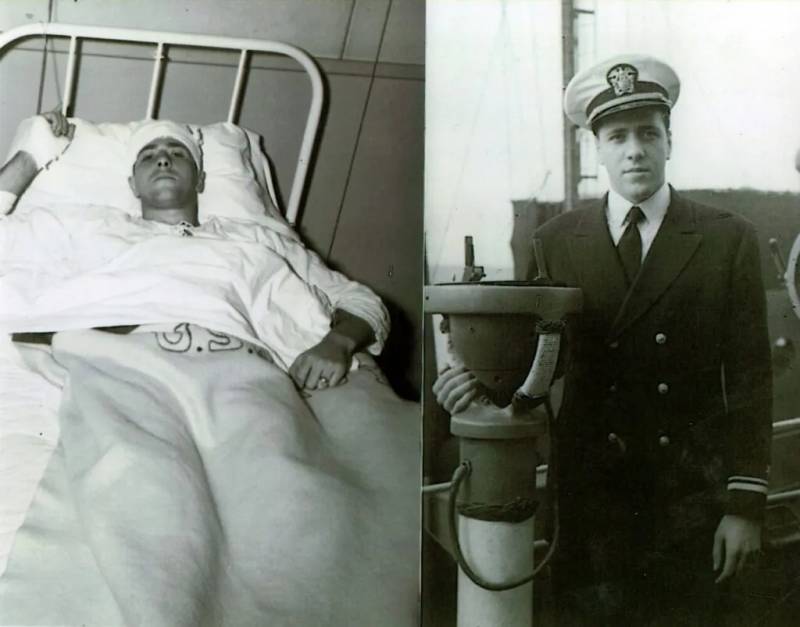
Second Lieutenant John Scagnelli at the gyrocompass on the Eagle's navigation bridge and at the naval hospital in Portland in May 1945. The only surviving officer from the crew of PE-56 and the only survivor of those on the stern of the ship
A week later, an official investigation into the sinking of the ship began in Portland, where five survivors stated that they saw a German submarine after the attack, with a yellow and red emblem on the wheelhouse. On April 24, having already boarded survivors, USS Selfridge (DD-357) attacked a submarine off Cape Elizabeth. The next day, not far from the site of the death of the Eagle, the frigate USS Muskegon (PF-24) detected the submarine with sonar and attacked it with depth charges, but to no avail. On May 5, 1945, off the coast of New England, less than 200 nautical miles from the site of the sinking of PE-56, a German submarine torpedoed the coal ship Black Point, en route from New York to Boston. A group of one destroyer, a frigate, two patrol vessels, supported by two naval airships, discovered and destroyed the submarine. It turned out to be U-853, on the wheelhouse of which there was an emblem in the form of a red horse against a yellow shield.
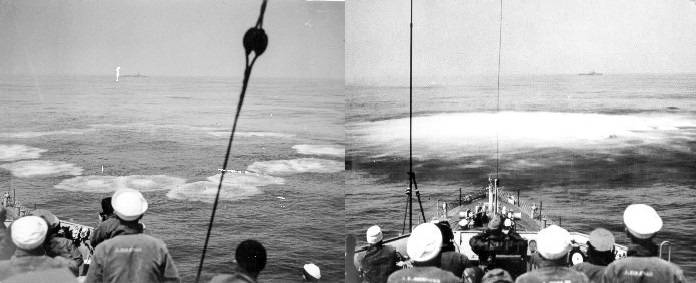
A series of photographs taken from the navigation bridge of the frigate USS Moberly (PF-63), depicting one of the attacks on the German submarine U-853, May 5, 1945. The first photo shows that the depth charges fired by the Hedgehog bomb launcher just plunged into the water, the second photo shows the result of their detonation. A group of four ships and two blimps (naval airships of soft construction) that joined them later hunted for a submarine for 16 hours on May 5 and 6, 1945. Several times the boat tried to break away from its pursuers, once it fell to the bottom, but was still overtaken
With all these facts before our eyes, the US Navy commission comes to the conclusion that the cause of death of PE-56 was... a boiler explosion. In addition to all the facts described above, Navy officials had before their eyes an act on a routine inspection and repair of the ship’s boilers, which was carried out several weeks before the tragedy. But the case was closed and put away on a distant shelf.

Front page of the Portland Press Herald news about the tragedy of PE-56. The cause of death of 49 sailors is designated as a “mysterious explosion”
Why did it happen? There are only theories regarding this. One of the most plausible sounds like this: the US Navy, which lost two ships off the Atlantic coast of the United States in one day, with catastrophic losses of personnel, decided to embellish the situation a little. The fact is that the day after the death of PE-56, that is, on April 24, 1945, an escort destroyer taking part in Operation Teardrop was killed by a torpedo from the submarine U-546. Like PE-56 the day before, the escort destroyer USS Frederick C. Davis (DE-136) broke almost in half and quickly sank.
115 crew members were killed. These losses were the last and penultimate losses of the US Navy from the actions of the German armed forces in World War II, while the death of PE-56 was also the largest single loss of US Navy personnel off the coast of New England during the entire war. And all this happened within a day, in its own territorial waters, when it was clear to everyone that Germany was about to capitulate. The situation, to put it mildly, is not very pleasant, showing the US Navy in a not very attractive light. And if the death of an escort destroyer participating in the operation to destroy the “wolf pack” off the Atlantic coast of the United States could hardly be attributed to an accident, then the explosion on an old ship built in 1919 could well be explained by technical problems.
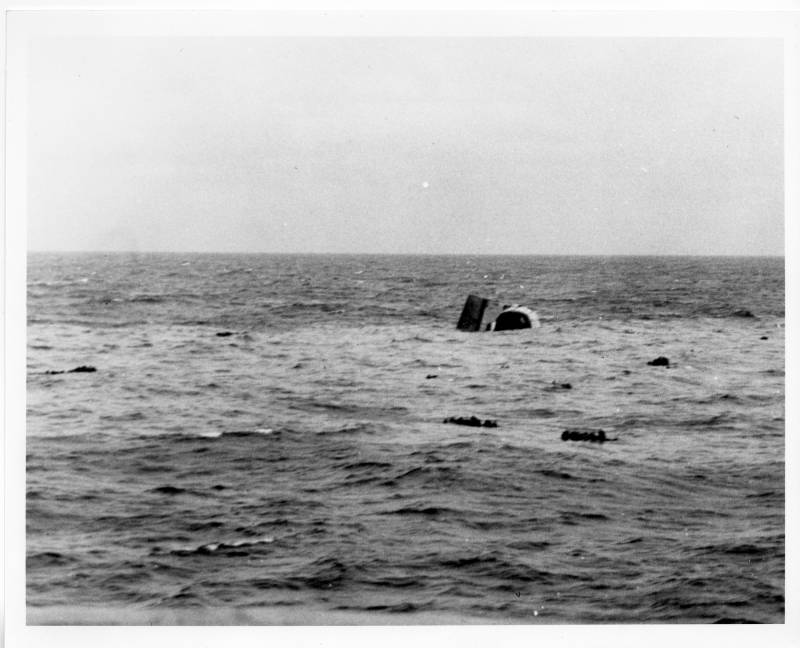
Photo taken on the afternoon of April 24, 1945, at the site of the sinking of the escort destroyer USS Frederick C. Davis (DE-136), after all survivors had been picked up
Justice triumphed.
On a cold March evening in a bar in Brockton, Massachusetts, Paul Lawton was drinking with his friends, brothers Bob and Paul Westerlund. After several beers and shots of Yukon Jack, the brothers told history his father, a sailor who was tragically killed by a boiler explosion on an old US Navy ship at the very end of the war. One of the brothers sadly added that their mother never believed in the official version of her husband’s death, and their father’s surviving colleagues said that immediately after the explosion they saw a submarine going under the water with a red and yellow emblem on the wheelhouse.

Lawton points to the map where PE-56 crashed, late 1990s. This photo accompanied one of the newspaper publications of the late 1990s, telling about the tragedy of April 23, 1945 and Lawton's investigation
Lawton, a lawyer by profession, was an amateur historian obsessed with the history of the Battle of the Atlantic. He became interested in the history of PE-56. Arriving home that evening, he took from the shelf the work of the German historian Jurgen Rover, dedicated to the actions of German submarines in the Battle of the Atlantic, and was surprised to find there a mention of the death of PE-56, and that, perhaps, the ship was sunk by U-853 . That is, the dead and wounded sailors from the Eagle did not receive the Purple Heart medal they deserved for death or injury from enemy actions, and the US Navy hushed up this story for so many years? It was the spring of 1998, more than 50 years had passed since the PE-56 tragedy, but Lawton decided to get to the bottom of the truth.
The first official request to the archives of the US Navy received an answer that all documents relating to the service of PE-56 at the end of the war, the tragedy and the official investigation... were lost. We can't help you, goodbye. Then Lawton turned to the archival records of US Navy ships that were in one way or another connected with the tragedy. And every time he came across confirmation that there was a submarine. Here is a record of a sonar contact, here is a destroyer dropping depth charges, here is an airship transmitting to a small hunter that he noticed the silhouette of a submarine. Infected by their friend's enthusiasm, the Westerlund brothers advertise in several newspapers looking for surviving sailors from PE-56. Several people responded to him, including one of the ship's mechanics, John Breese, who said that in 1945 he swore under oath that the cause of the ship's death could not be a boiler explosion, and is ready to confirm this now.

John Breeze photographed during an interview for the American pay-TV channel Smithsonian Channel, 2010s
Collecting more and more new facts, Lawton constantly wrote to Navy officials and constantly received the same answers - all documents relating to the death of PE-56 and the official investigation were lost, the case could not be reconsidered.
Lawton was already ready to give up; it seemed impossible to break through the blank wall of the naval bureaucracy. Coming home from work one rainy October evening in 1999, Lawton saw a heavy package on the threshold, which clearly contained documents or a book. There were no marks indicating the sender on the package itself, nor was there any note or covering letter attached. Entering the house, Lawton tore open the packaging... In front of him lay an official copy of the report of the commission investigating the death of PE-56, dated May 1945. One of the interim results of the investigation was the conclusion that the explosion was caused by "German mine or torpedo" He never found out who sent him the “lost” naval document, but it didn’t matter anymore; the historian-enthusiast set to work with renewed vigor.
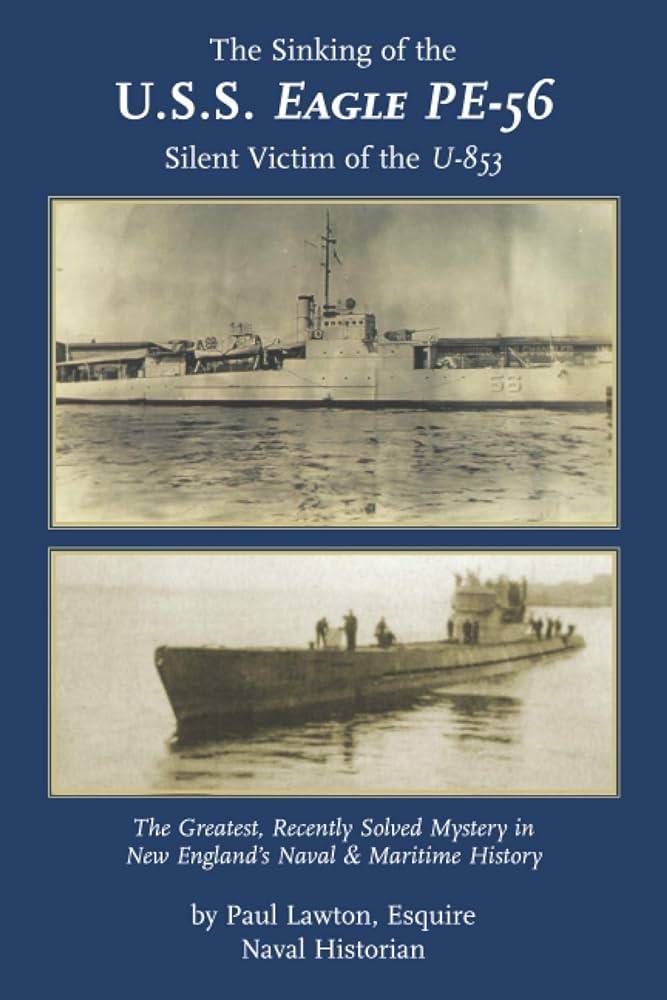
A book written by Lawton based on his investigation. The epigraph is rather pompous, but at the same time accurate in content
Lawton Sr., a former state judge, was involved in breaking through the naval bureaucracy, who asked for help from his friend the senator. There were several press publications initiated by relatives of the surviving and dead sailors who wanted the case reviewed. Lawton was inundated with letters from military historians in the United States and Europe, and eventually gained access to German archives, which contained copies of radio messages from U-853, one of which spoke of a successful torpedo attack off the coast of New England on April 23, 1945.
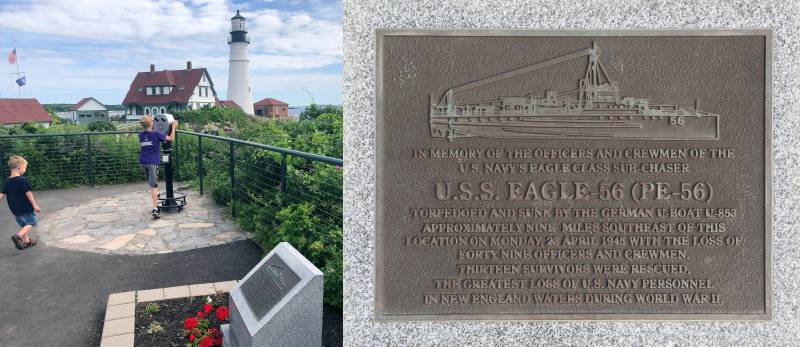
A memorial plaque that was installed on an observation deck near the Cape Elizabeth lighthouse, a few miles from the site of the sinking of PE-56
Finally, in 2001, naval bureaucrats capitulated. It was recognized that PE-56 was a victim of enemy action, that the commission's initial conclusions were incorrect, and that the dead and wounded sailors were awarded Purple Heart medals. This marked the only time in the history of the US Navy that the results of an official investigation into the sinking of a US Navy vessel were revised. It was never recognized that the fact of the torpedoing of the ship was deliberately hidden, and there was no point in it - few of those involved in the possible deliberate concealment were alive, there was no one to punish. And it didn’t matter to the relatives of the victims and the survivors; justice had triumphed, even if almost 56 years later, they received the awards and honors due to them. And in 2019, probably the last page in the history of PE-56 was turned: on July 24, five miles from the coast, at a depth of 90 meters, the sunken ship itself was found.
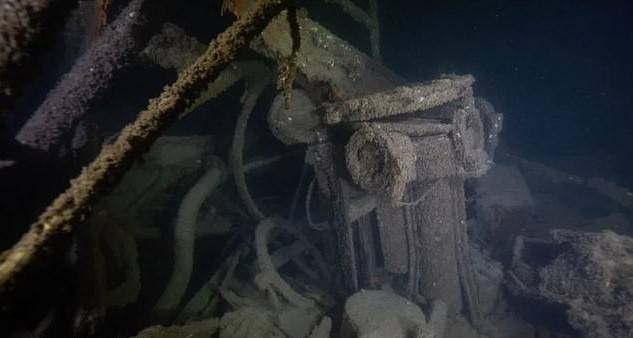
The PE-56 navigation bridge, filmed by divers in 2019
Information